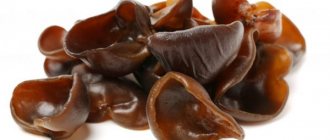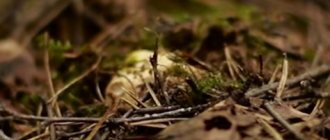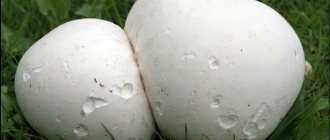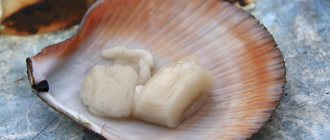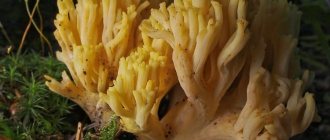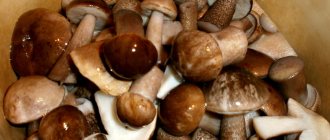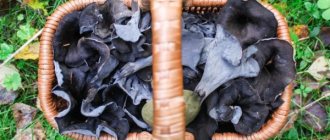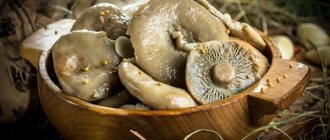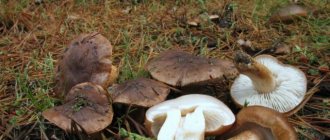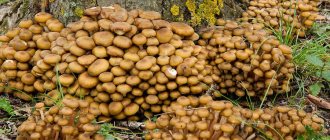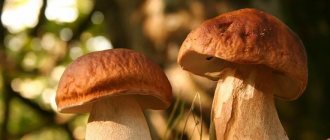Mushrooms
0
1604
Article rating
Kira Stoletova
The world of mushrooms is large and diverse, and the idea of the total number of species is constantly changing. Mushrooms do not belong to either the animal or plant world - they simply stand apart and have a lot of useful properties for humans. Particularly interesting is the black muer mushroom, which grows in Asia.
Black muer mushroom
What kind of muer mushroom is this?
Only in its homeland this delicacy is called muer; in other countries it is “tree ear”, “Judas ear”. Translated from Japanese as “tree jellyfish”. Originally found in Japan as part of dishes served at imperial receptions. Tiger lily combined with muer was considered the height of sophistication.
The Chinese, as lovers of various exotic foods, have been using mushrooms since ancient times. Later, trading with the East, European countries began to purchase the product - Scotland, Ireland, Germany.
What does it look like
This black tree mushroom is thin and fragile, similar to oyster mushrooms. At first glance, it seems as if there is charred paper or an ear in front of your eyes. Auricularia ear-shaped grows close to the tree, since its stalk is short. The gelatinous pulp is very thin and translucent. The mushroom is rough on the outside, smooth on the inside. Size up to 10 centimeters. As it dries, it slightly decreases in size and hardens. The white spores are ellipsoidal in shape.
Actually, muer has 2 types: hairy and ear-shaped. But the most famous is the second one, it is more attractive in appearance. The first has a fluffy gray-brown upper part with gray-white flesh.
Where does it grow
Mushrooms are most often found in the forests of China, Thailand, Vietnam, and less often in eastern Russia. They prefer trees of the alder family: oak, alder, maple, elderberry. Muer parasitizes weakened and dead trees. Rarely grows alone, usually in an overgrown colony.
What does muer taste like?
This is a mushroom with a sweetish crispy flesh and a slight smoky smell. Due to its neutral taste, muer goes well with many foods. It is added to cold salads and appetizers, first and second courses, and is not prepared as a main course due to the same taste neutrality.
Video:
auricularia ear - description, benefits and harm Expand
Mycological characteristics
Belongs to Agaricomycetes from the Auriculariaceae family.
- The fruiting body is sessile, resembling an auricle. The size ranges from 4 to 10 cm. The color of the outer shell is reddish-brown, sometimes closer to black. The surface is covered with hairs that are soft to the touch.
- Hymenophore. Formed by an inner layer with a smooth structure. The color is darker than the outer cover and has a gray tint. Veins and wrinkles are visible.
- The pulp is thin, up to 5 mm, with a consistency similar to jelly. The color is transparent. The smell is not pronounced. As it dries, it becomes hard and contracts (shrinks).
- Reproduction. It reproduces by elongated ellipsoidal spores reaching a size of up to 5*14 microns. The color of the spore powder is white.
Distributed in warm climate areas of the northern zone with moderate weather conditions.
Grows on dead wood and deciduous trees weakened by pests and diseases as a parasitic fungus or saprotroph. Prefers elderberry and alder.
It grows year-round in large colonies, but is extremely rare alone. In the winter season it bears fruit in warm weather.
In nature, it has a similar appearance in description - auricularia densely hairy, which is often found in tropical forests. It is distinguished by a pinkish tint of the hymenophore and a yellow or grayish surface shell.
Beneficial properties of muer mushrooms
Thanks to the presence of protein, vegetarians and people leading a healthy lifestyle can use this product in any dish without a twinge of conscience. In terms of iodine, which is indispensable for the normal functioning of the thyroid gland, it is not inferior to seaweed, seaweed and chuka. In addition, it is a good natural antioxidant that helps eliminate free radicals. Nicotinic acid helps the body recover and renew itself faster. The enzymes contained in muer prevent the formation of blood clots. Polysaccharides increase immunity and reduce the likelihood of cancer.
Mushrooms are useful for diabetes, anemia, obesity, hypertension, as they reduce cholesterol and improve the functioning of the heart and blood vessels. Heparin prevents blood clotting and fights blood clots. Frequent use of muer relieves irritation of the gastric mucosa and normalizes its acidity. The product will help cope with swelling and premature aging.
What apple tree diseases does this indicate?
Mushrooms in our usual understanding are not just an object with a stem and a cap. There are a huge variety of their types - mold, lichens, moss, etc.
The most common fungal diseases of such a crop as an apple tree are considered to be:
- Scab is a harmful disease caused by the marsupial species Venturiainaequalis;
- Mold (fungal plaque) - the color can be very diverse, depending on the type. For example, powdery mildew, caused by powdery mildew fungi (Erysiphales);
- Rust - damage by rust species;
- Cytosporosis - from the microscopic fungus Cytospora;
- Anthracnose – causative agent Cryptosporiopsismalicorticis (Cordley) Nannf;
- Tubercularia - infection with the Nectria fungus (tubercularia);
- Alternaria blight - caused by a fungus of the Alternaria alternata species;
- Moniliosis – caused by marsupials belonging to the genus Monilinia;
- Milky sheen - spores penetrate damaged parts of the plant;
- Black crayfish is the causative agent of Sphaeropsismalorum Peck, class Deuteromycetes.
Do lichens and mosses cause harm? This topic is still not fully studied and controversial. Most experts believe that they are not the main reasons for the death of this culture.
Harm and contraindications
The mushroom is non-toxic and cannot be confused with its poisonous counterparts. But such an instance also has its drawbacks.
- Muer is dangerous and contraindicated for people with liver disease.
- For allergy sufferers, it can provoke a severe reaction in the form of skin dermatitis and eczema.
- The mushroom is contraindicated in children, since the body at this age lacks enzymes that allow the absorption of chitin.
- Not recommended for pregnant and lactating women.
- Do not forget that in the wild, muers can absorb substances that can cause poisoning and eating disorders.
Criteria for distinguishing edible from inedible tree mushrooms
If you take a closer look at tree mushrooms and how they grow, you can easily distinguish poisonous specimens from edible ones.
The main differences between dangerous mushrooms:
- If a tree fungus does not have a stalk and grows directly from the trunk, then most likely it will be poisonous.
- A large, wide cap also indicates that the mushroom is inedible.
- Edible tree mushrooms do not have bright red, bright orange or brown flesh.
External differences between edible and poisonous mushrooms
Using these signs, you can easily identify dangerous poisonous specimens.
Use of muer mushrooms in medicine
Eastern medicine is famous for its desire to use as many natural resources as possible for various medicinal tinctures and ointments.
- Products made from muer treat skin diseases and also have a healing effect.
- For a long time, knowing the beneficial properties of the delicacy, Chinese healers used it to treat diseases of the throat and eyes. Used as a mild antibiotic affecting the upper respiratory tract.
- The mushroom, having absorbent properties, can become an alternative to activated carbon in case of severe poisoning. Used to prevent diseases of the digestive tract.
- Muer is used even in the recovery period after chemical and radiation therapy.
- Auricularia fights blood clots and prevents their formation.
Types of mushrooms
Real, or autumn. The color can vary from light brown to brown with a reddish tint. Mushrooms growing on poplar or acacia stumps are light yellow, while those growing on pine or spruce are brown-red. The middle of the cap is covered with light scales, they are also called freckles. The thin stem always has a membranous light ring - this is the main difference between a real honey mushroom and a false one. Honey mushrooms are fried, salted, pickled, added to soups or pie fillings.
Tuberous. The hat is gray, the collar on the stem is thin. The freckles are located in the center, and the edges of the honey fungus are always smooth. In older specimens, the ring under the cap may disappear. They grow in deciduous forests.
Northern. These are mushrooms that are distinguished by an orange, honey or yellow hue. There is a white edge on the leg instead of a thin ring. These honey mushrooms grow on the stump in huge columns, often taking over nearby trees.
Thick-legged. The color is brown or brown. The leg is thick, the cap is convex, with rough scales. Mushrooms can be found on the stump of deciduous trees; they grow in small groups.
Dark. A thick mushroom of brown or dark brown color. It grows in coniferous forests; it grows extremely rarely on living trees, preferring stumps.
The main signs of poisonous mushrooms:
- absence of a ring (collar) under the hat;
- bright yellow or bright red color of the plates;
- smooth, thin legs narrowed to the base;
- in old specimens the plates are pale, often green;
- the taste is very bitter, but it is dangerous to try.
How to choose and store muer correctly
Most often, mushrooms are sold dried in oriental spice stores at quite reasonable prices. It is important that they are dry, without moisture on the packaging. A smooth black or dark gray color is considered ideal. But most often light varieties come across on sale. The product is unusable if white and green spots are visible. Most likely, at some stage of packaging or transportation, moisture got into the bag and mold formed.
When storing dried mushrooms in a dry place, the shelf life can reach 5 years. If, after preparing dishes, there is a certain amount of soaked muer left, it is advisable to use them within 2-3 days.
We recommend reading:
enoki mushrooms: description, benefits and harms, application
Read
Growing technology
Tree mushrooms grow not only in natural conditions. They are grown artificially. The technologies are similar to the methods of cultivating champignons.
On plant residues in bags
Planting technology:
- prepare a homogeneous (for example, only from hay) or combined (straw, hay and sawdust are taken in equal proportions) substrate by pouring boiling water over the plant residues and keeping them at a temperature of 20℃-30℃ until completely cooled;
- squeeze out the prepared mixture and mix with powdered mycelium at the rate of 1 package of mycelium for every 15 kg of wet substrate (some manufacturers indicate that 1 package of mycelium goes for 40 kg of substrate, but it all depends on the initial mass of planting material);
- Place the resulting mixture in a plastic bag, compact it a little and tie it tightly. Instead of polyethylene, you can take spunbond or lutrasil - a black non-woven covering material;
- For air circulation, cuts 3-5 cm long are made in the bag.
Mushroom blocks are placed indoors or outdoors in dark places where direct sunlight does not reach. The best option is to hang them at a low height.
The average price of mycelium is 180-200 rubles.
After 3-4 weeks, the germination of the mycelium is observed in the form of white or yellowish pubescence, which over time acquires a dense structure.
The rudiments of fruiting bodies appear after 2 weeks. Where they appeared, the film is cut. At this stage, the plantings will require sunlight for further development.
The tree mushroom bears fruit in waves, at intervals of 2-3 weeks. The largest harvest occurs during the first fruiting.
How to cook muer mushrooms: recipes
The fact is that this delicacy has practically no mushroom taste, but it can be fried, boiled, or pickled. Can be added raw to salads. Before cooking, you need to soak for several hours, because mushrooms are sold dried. Compatible with many products. So now onto some recipes.
Cold appetizers
Restaurants in Japan are famous for cold snacks from muer and they are in great demand, and therefore they are served in many Chinese restaurants both at home and around the world. In China, the delicacy is served before the first courses are served.
Most often, appetizers include ginger, garlic, cilantro, and black rice vinegar. The combination of such ingredients awakens the appetite and helps digestion.
Thanks to the unusual presentation and taste, these types of snacks have taken root in Russia.
They are easy to prepare, inexpensive, and therefore everyone can pamper themselves with the delights of oriental cuisine.
For a cold appetizer of “Chinese ears” you need:
- dried mushrooms - 5 pcs.;
- black soy vinegar - 1 tbsp. l.;
- light soy sauce - 2 tbsp. l.;
- sesame oil - 1 tsp;
- sugar - 1 tsp;
- garlic - 3 cloves;
- cilantro - 3 sprigs;
- ginger - 3 circles;
- salt, chili pepper to taste.
First you need to prepare the mushrooms so that they soften and restore elasticity. This can be done in two ways:
- Soak in warm water overnight.
- Soak for half an hour, then blanch in boiling water for 5 minutes, drain on a sieve, and rinse with cold water.
While the muers are cooling, stir in the sauce. Mix sesame oil, black rice vinegar, light soy sauce and sugar, after dissolving the dressing will be ready.
Peel the garlic, cut off the skin of the ginger, rinse the cilantro and chili. Chop the ginger and garlic as finely as possible. Finely chop the greens and cilantro stem. Cut off a few rings from the chili pepper. The more of it, the spicier the dish.
Squeeze the mushrooms, cut off the dense part, cut into strips. Here, as you like, you can make it wider or thinner.
Transfer the chopped muer to a salad bowl. Top with dressing sauce. Add chopped ginger, garlic, chili, cilantro. Mix everything, cover with film. To allow the appetizer to soak and cool, place it in the refrigerator.
Stir again and when placing on a plate, garnish with the remaining sauce, pepper and cilantro. And you can start tasting.
Pasta with mushrooms and chicken breast
To prepare the dish you will need:
- Muer - 15 years
- Chicken breast - 3 pcs.
- Pasta - 130 g.
- Smoked paprika, ground black pepper, khmele-suneli - all in a teaspoon.
- Onion - 1 pc.
- Vegetable oil.
- Corn starch - 2 tsp.
- Milk - 50 ml.
Cooking:
- Pour boiling water over the mushrooms for an hour.
- Cut the breasts into strips, finely chop the garlic, onion, and grate the carrots. Place the ingredients in a bowl, pour in the milk, add starch, salt, and spices. Everything must be marinated.
- After the “ears” have increased by 7-8 times, rinse under the tap and chop coarsely.
- Next, fry the chopped breasts in vegetable oil, stirring occasionally. Boil the pasta, drain in a colander. Then mix with breasts and mushrooms. Simmer it all for another 5-7 minutes and you can serve it.
Video:
Korean tree mushroom salad Expand
Eggplant with muer mushrooms in sesame sauce
The dish includes:
- Eggplant - medium size.
- Red pepper - medium size.
- Muer mushrooms - 20 g.
- Soy sauce - 4 tbsp. l.
- Sesame paste - 3 tbsp. l.
- Rice vinegar - 2 tbsp. l.
- Sugar - 5 tsp.
- Starch - 3 tbsp. l.
- Garlic - 4 cloves.
- Hot water - 150 g.
- Vegetable or olive oil for frying.
- Cilantro and green onions to taste for garnish.
- Salt - to taste.
Cooking:
- Wash the pepper, eggplant, green onions, peel the garlic. Pour boiling water over the mushrooms and place on low heat for 15-20 minutes.
- Cut the eggplant into large cubes and add salt to avoid bitterness.
- Coarsely chop the pepper. Grate the garlic on a fine grater. Remove the “ears” from the pan.
- If you don’t have sesame paste, you can make your own from sesame seeds and vegetable or olive oil. To do this, first fry the raw sesame seeds in a dry hot frying pan, stirring and not overcooking so that they do not turn brown later in the paste. Grind in a coffee grinder or blender, mix with olive oil. This mixture can be stored in a tightly closed container for about 2 weeks. Ready-made sesame paste contains vitamins E, C, A, group B, amino acids, as well as phosphorus, iron, calcium, zinc, copper, Omega.
- Chop the mushrooms, removing the hard parts. Wash the eggplant, dry on a paper towel, sprinkle with starch. Fry evenly. Quickly fry the pepper over high heat. Drain both vegetables on paper towels.
- Add vegetable oil to a heated frying pan, add garlic, white part of green onions, sugar, soy sauce, rice vinegar, sesame paste and constantly stir. Add mushrooms, simmer for 2 minutes, followed by peppers and eggplants. Pour in water. Bring to a boil, cook for a couple of minutes, stirring. Serve sprinkled with cilantro and green onions.
The dish is delicious both hot and cold.
Tree mushroom soup
Ingredients for four servings:
- Mushrooms - 15 g.
- Chicken fillet - 400 g.
- Water - 1 liter.
- Peanut butter - 15 g.
- Ginger - 25 g.
- Wine - 50 ml.
- Soy sauce - 60 ml.
- White pepper - 1 g.
- Garlic arrows.
How to cook:
- Rinse the fillet, chop coarsely, put in a saucepan, add water, put on fire and bring to a boil. Cook until fully cooked.
- Peel the ginger and chop finely. Coarsely chop the garlic arrows.
- Heat peanut oil. Fry the ginger for two minutes. Transfer to broth, pour wine, soy sauce. Cook for another 5-10 minutes. Remove from heat. The soup is ready.
Pork fries with mushrooms
Ingredients:
- Pork - 150 g.
- Muer mushrooms – 25 g.
- Onion - 150 g.
- Vegetable oil for deep frying - 0.5 liters.
- Soy sauce - 20 g.
- Monosodium glutamate - 2 g.
- Wine or cognac - 10 g.
- Vinegar - 5 g.
- Starch - 75 g.
- Ginger - 5 g.
- Garlic - 10 g.
- Salt to taste.
How to cook:
- Cut the pork into 3 mm thick and about 3 cm long. Place in a bowl and add salt. Pour in a couple of tablespoons of water and wine. Add starch, monosodium glutamine, onion cut into triangular slices and sliced mushrooms.
- Separately mix soy sauce, vinegar, monosodium glutamate, salt and starch diluted with water.
- Grill each piece of pork until crispy.
- Drain almost all the oil, leaving a little for frying onions, mushrooms, garlic, ginger. Add and mix spices. Simmer until thickened. Then add the fried pork. Mix everything thoroughly. The dish is served hot.
Appetizer of tree mushrooms with funchose
For the dish you will need:
- Mushrooms - 20 g.
- Funchoza - 120 g.
- Carrots - 1 medium.
- Onion - 1 medium.
- Smoked chicken fillet - 250 g.
- Garlic - 3 cloves.
- Cucumber - 1 medium.
- Vegetable oil - for frying.
- Salt, sugar, soy sauce.
Recipe:
- Pre-soak the mushrooms. Chop the onion into rings. Grate the carrots on a coarse grater. Coarsely chop the muer. Fry these vegetables in a frying pan in oil, stirring. Grind the chicken. Boil the funchose. Grate the cucumber.
- Cool the noodles, vegetables and mix. Season with soy sauce, chopped garlic and spices.
- Place in the refrigerator for a couple of hours. This dish is perfect for a holiday table.
Funchoza with muer, beef in coconut milk
This delicacy is suitable for lovers of sweet and sour dishes.
Ingredients:
- Muer - 40 g.
- Beef - 350 g.
- Coconut milk - 200 ml.
- Funchoza - 250 g.
- Onion - 1 medium.
- Red pepper - 1 pc.
- Salt, pepper - to taste.
- Greenery - for decoration.
Step by step recipe:
- Soak the mushrooms for 3 hours. Cut the meat into strips, fry in a frying pan with seasonings, add onion cut into half rings. “Ears”, chop the pepper into strips, place in a frying pan. Pour in coconut milk and salt. Simmer over low heat, stirring, for about 20 minutes.
- Cook the funchose for 4 minutes. Drain the water and transfer to the meat. Sprinkle with herbs.
Varieties of tinder fungus
Different types of tinder fungus prefer different hosts. For example, the false polypore (Phellinus igniarius) appears more often on stone fruit trees and pear trees. The fruiting body of the mushroom is perennial and increases in size every year. The color of the upper part is yellow-brown, grayish-black, matte, with edges of a lighter shade. The appearance of black veins in the wood and white core rot indicate infection of the tree.
The red plum polypore (Phellinus tuberculosus) appears on plum, bird cherry, hawthorn, and sometimes on apple or pear trees. When a tree is damaged in this way, its trunk and branches quickly dry out. The fruiting body of the fungus is hoof-shaped, the velvety upper part is covered with a smooth crust with a rusty edging. Infected wood becomes yellow with brown stripes, and rot spreads throughout the entire trunk, including the roots of the plant.
Old deciduous trees are loved by the flat polypore ( Ganoderma applanatum
). It usually appears on the roots or root zone of the tree, then white or slightly yellowish rot creeps up, eating the core. The upper surface of the perennial fruiting body is whitish-brown or rusty-brown with grooves and wavy edges. The caps are flat and located next to each other.
Also, the real tinder fungus (Fomes fomentarius) settles on weakened fruit trees. The wood of a tree infected with white or light yellow rot is stratified, starting from the core, along the annual rings. The old mushroom grows to a very large size, it looks like a pale gray hoof with grooves and light yellow edges.
The sulfur-yellow polypore (Laetiporus sulphureus) prefers cherries. It forms brown heart rot that quickly spreads throughout the wood. The fruiting bodies are annual, connected like tiles. Their watery, fleshy tissue with a wavy, light yellow surface hardens and becomes brittle.
The annual mushroom bodies of the scaly polypore (Cerioporus squamosus) select pear. They have a small stem, a semicircular shape and a flat top. These mushrooms are located low above the ground in groups. Their color varies from light yellowish to brown, with dark brown scales arranged in a fan-shaped pattern.
Plum red polypore (Phellinus tuberculosus). Amadej Trnkoczy
How to grow muer at home
Two cuts are made in the beams and prepared by soaking them in water for a week. Then the mycelium of the fungus is placed on these branches. Deciduous trees are suitable for this; muers do not grow on conifers in nature. It is best to use meter-long branches with an average diameter of about 15 centimeters. They are usually planted in spring, in April-May. Mushrooms germinate within three months at an average temperature of 20 degrees. After emergence, it is necessary to move the logs to a place protected from the sun.
If the summer has been humid and warm, the first harvest will appear at the end of the season. Muer can be collected when white pores appear at the bottom of the cap. Under favorable conditions, mushrooms will bear fruit for about 6 years.
Precautions for use
It is important to understand that every medicine has contraindications. This also applies to the use of tree mushrooms for medicinal purposes. They are not given to children under 14 years of age due to their high chitin content. People who suffer from allergies or have an individual intolerance to the product cannot be treated in this way.
Purchasing dry raw materials (dried muer, chaga) requires compliance with certain rules. Before use, such mushrooms should be soaked in water for a long time and subjected to thorough heat treatment. This will destroy bacteria and enhance antioxidant properties.
Before use, dry mushrooms should be soaked or boiled several times.
You should not collect medicinal tree mushrooms on your own, as there is a risk of making a mistake that will lead to serious health consequences. In addition, mushrooms absorb harmful substances from the environment well, while store-bought ones are grown in specially designated areas.
